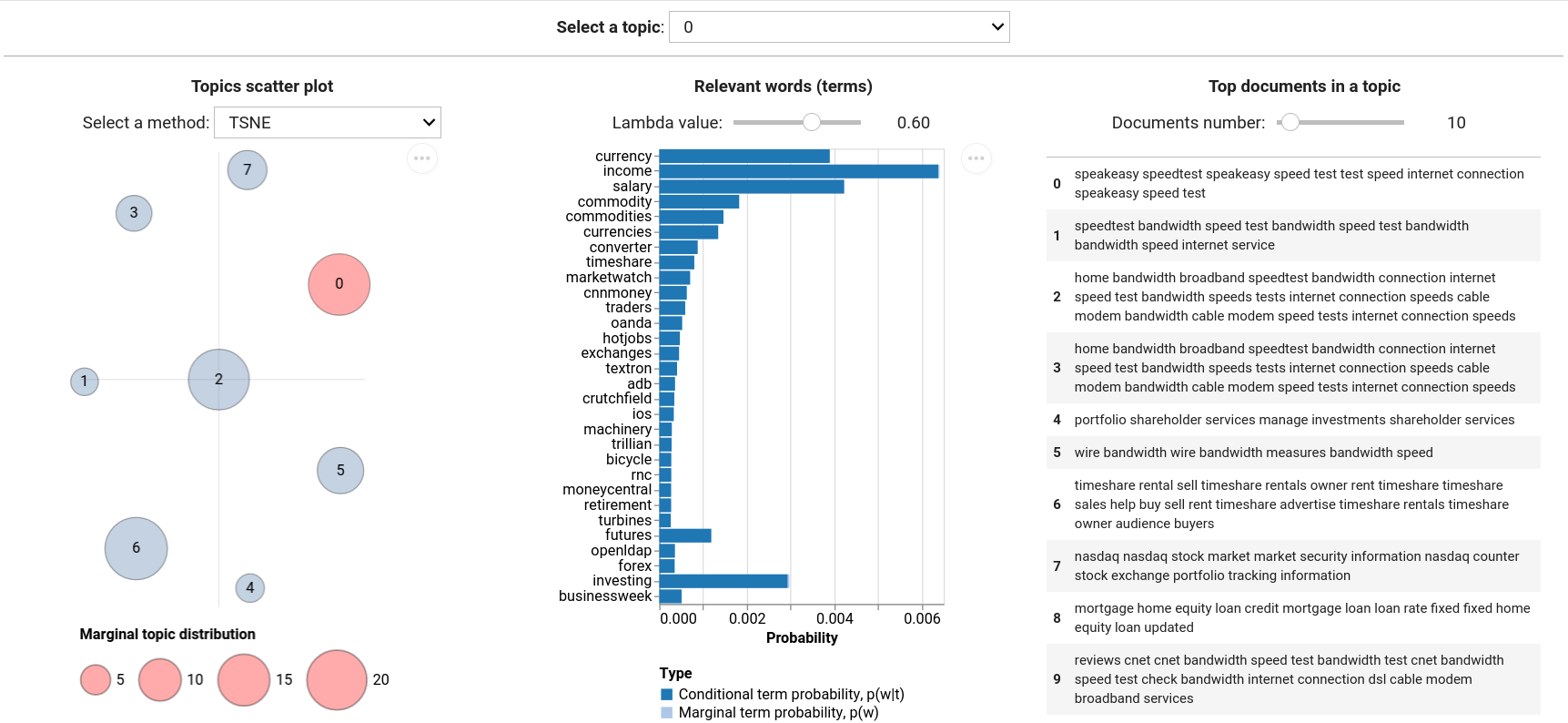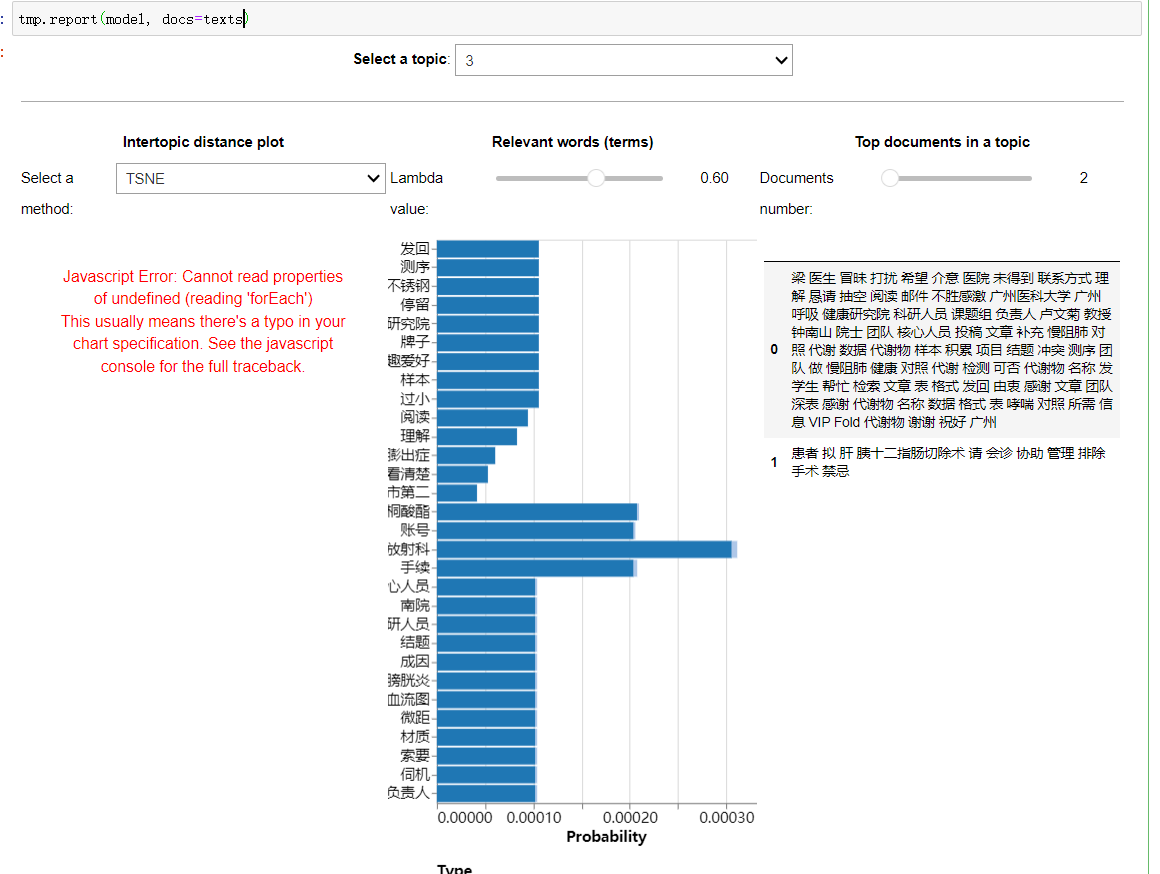And then the below error is produced by it. Maybe I am the one at fault here but I can't see why the problem arises, It has worked when doing the same thing previously (on a different dataset).
I am utilizing the latest release of tmplot.
Thank you for any possible assistance and I apologize beforehand if have made any mistake, this is my first issue raised here on GitHub.
AttributeError Traceback (most recent call last)
Cell In[19], line 2
1 #Calculate coordinates
----> 2 topics_coords = tmp.prepare_coords(model)
File ~\Anaconda3\lib\site-packages\tmplot\_report.py:44, in prepare_coords(model, labels, dist_kws, scatter_kws)
42 theta = get_theta(model)
43 topics_dists = get_topics_dist(phi, **dist_kws)
---> 44 topics_coords = get_topics_scatter(topics_dists, theta, **scatter_kws)
45 topics_coords['label'] = labels or theta.index
46 return topics_coords
File ~\Anaconda3\lib\site-packages\tmplot\_distance.py:177, in get_topics_scatter(topic_dists, theta, method, method_kws)
174 elif method == 'isomap':
175 transformer = Isomap(**method_kws)
--> 177 coords = transformer.fit_transform(topic_dists)
179 topics_xy = DataFrame(coords, columns=['x', 'y'])
180 topics_xy['topic'] = topics_xy.index.astype(int)
File ~\Anaconda3\lib\site-packages\sklearn\manifold\_t_sne.py:1119, in TSNE.fit_transform(self, X, y)
1117 self._validate_params()
1118 self._check_params_vs_input(X)
-> 1119 embedding = self._fit(X)
1120 self.embedding_ = embedding
1121 return self.embedding_
File ~\Anaconda3\lib\site-packages\sklearn\manifold\_t_sne.py:963, in TSNE._fit(self, X, skip_num_points)
956 print(
957 "[t-SNE] Indexed {} samples in {:.3f}s...".format(
958 n_samples, duration
959 )
960 )
962 t0 = time()
--> 963 distances_nn = knn.kneighbors_graph(mode="distance")
964 duration = time() - t0
965 if self.verbose:
File ~\Anaconda3\lib\site-packages\sklearn\neighbors\_base.py:988, in KNeighborsMixin.kneighbors_graph(self, X, n_neighbors, mode)
985 A_data = np.ones(n_queries * n_neighbors)
987 elif mode == "distance":
--> 988 A_data, A_ind = self.kneighbors(X, n_neighbors, return_distance=True)
989 A_data = np.ravel(A_data)
991 else:
File ~\Anaconda3\lib\site-packages\sklearn\neighbors\_base.py:824, in KNeighborsMixin.kneighbors(self, X, n_neighbors, return_distance)
817 use_pairwise_distances_reductions = (
818 self._fit_method == "brute"
819 and ArgKmin.is_usable_for(
820 X if X is not None else self._fit_X, self._fit_X, self.effective_metric_
821 )
822 )
823 if use_pairwise_distances_reductions:
--> 824 results = ArgKmin.compute(
825 X=X,
826 Y=self._fit_X,
827 k=n_neighbors,
828 metric=self.effective_metric_,
829 metric_kwargs=self.effective_metric_params_,
830 strategy="auto",
831 return_distance=return_distance,
832 )
834 elif (
835 self._fit_method == "brute" and self.metric == "precomputed" and issparse(X)
836 ):
837 results = _kneighbors_from_graph(
838 X, n_neighbors=n_neighbors, return_distance=return_distance
839 )
File ~\Anaconda3\lib\site-packages\sklearn\metrics\_pairwise_distances_reduction\_dispatcher.py:277, in ArgKmin.compute(cls, X, Y, k, metric, chunk_size, metric_kwargs, strategy, return_distance)
196 """Compute the argkmin reduction.
197
198 Parameters
(...)
274 returns.
275 """
276 if X.dtype == Y.dtype == np.float64:
--> 277 return ArgKmin64.compute(
278 X=X,
279 Y=Y,
280 k=k,
281 metric=metric,
282 chunk_size=chunk_size,
283 metric_kwargs=metric_kwargs,
284 strategy=strategy,
285 return_distance=return_distance,
286 )
288 if X.dtype == Y.dtype == np.float32:
289 return ArgKmin32.compute(
290 X=X,
291 Y=Y,
(...)
297 return_distance=return_distance,
298 )
File sklearn\metrics\_pairwise_distances_reduction\_argkmin.pyx:95, in sklearn.metrics._pairwise_distances_reduction._argkmin.ArgKmin64.compute()
File ~\Anaconda3\lib\site-packages\sklearn\utils\fixes.py:139, in threadpool_limits(limits, user_api)
137 return controller.limit(limits=limits, user_api=user_api)
138 else:
--> 139 return threadpoolctl.threadpool_limits(limits=limits, user_api=user_api)
File ~\Anaconda3\lib\site-packages\threadpoolctl.py:171, in threadpool_limits.__init__(self, limits, user_api)
167 def __init__(self, limits=None, user_api=None):
168 self._limits, self._user_api, self._prefixes = \
169 self._check_params(limits, user_api)
--> 171 self._original_info = self._set_threadpool_limits()
File ~\Anaconda3\lib\site-packages\threadpoolctl.py:268, in threadpool_limits._set_threadpool_limits(self)
265 if self._limits is None:
266 return None
--> 268 modules = _ThreadpoolInfo(prefixes=self._prefixes,
269 user_api=self._user_api)
270 for module in modules:
271 # self._limits is a dict {key: num_threads} where key is either
272 # a prefix or a user_api. If a module matches both, the limit
273 # corresponding to the prefix is chosed.
274 if module.prefix in self._limits:
File ~\Anaconda3\lib\site-packages\threadpoolctl.py:340, in _ThreadpoolInfo.__init__(self, user_api, prefixes, modules)
337 self.user_api = [] if user_api is None else user_api
339 self.modules = []
--> 340 self._load_modules()
341 self._warn_if_incompatible_openmp()
342 else:
File ~\Anaconda3\lib\site-packages\threadpoolctl.py:373, in _ThreadpoolInfo._load_modules(self)
371 self._find_modules_with_dyld()
372 elif sys.platform == "win32":
--> 373 self._find_modules_with_enum_process_module_ex()
374 else:
375 self._find_modules_with_dl_iterate_phdr()
File ~\Anaconda3\lib\site-packages\threadpoolctl.py:485, in _ThreadpoolInfo._find_modules_with_enum_process_module_ex(self)
482 filepath = buf.value
484 # Store the module if it is supported and selected
--> 485 self._make_module_from_path(filepath)
486 finally:
487 kernel_32.CloseHandle(h_process)
File ~\Anaconda3\lib\site-packages\threadpoolctl.py:515, in _ThreadpoolInfo._make_module_from_path(self, filepath)
513 if prefix in self.prefixes or user_api in self.user_api:
514 module_class = globals()[module_class]
--> 515 module = module_class(filepath, prefix, user_api, internal_api)
516 self.modules.append(module)
File ~\Anaconda3\lib\site-packages\threadpoolctl.py:606, in _Module.__init__(self, filepath, prefix, user_api, internal_api)
604 self.internal_api = internal_api
605 self._dynlib = ctypes.CDLL(filepath, mode=_RTLD_NOLOAD)
--> 606 self.version = self.get_version()
607 self.num_threads = self.get_num_threads()
608 self._get_extra_info()
File ~\Anaconda3\lib\site-packages\threadpoolctl.py:646, in _OpenBLASModule.get_version(self)
643 get_config = getattr(self._dynlib, "openblas_get_config",
644 lambda: None)
645 get_config.restype = ctypes.c_char_p
--> 646 config = get_config().split()
647 if config[0] == b"OpenBLAS":
648 return config[1].decode("utf-8")
AttributeError: 'NoneType' object has no attribute 'split'









